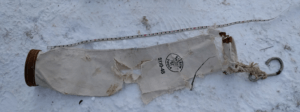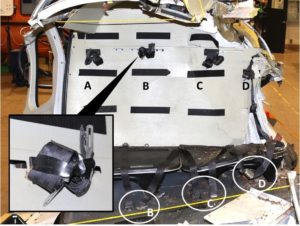Unclear procedures for carrying external loads has been identified by the Transportation Safety Board of Canada (TSB) as a key factor in the fatal crash of a Hydro One AS350 B2 helicopter near the eastern Ontario community of Tweed in December 2017.

In its final report released on Oct. 30, 2019, the TSB added that there is also a dangerous regulatory “ambiguity” in the Canadian Aviation Regulations (CARs) concerning passengers’ safety belts.
The main cause of the crash, which killed the pilot and the three power line technicians on board, had already been identified as a canvas supply bag which flew off the helicopter’s starboard external AirStair platform at an altitude of 230 feet, striking the tail rotor and resulting in a catastrophic loss of control as the helicopter came in for a landing.
The pilot remained belted into the spinning helicopter but the three technicians were ejected before impact. Investigators found two of the three lap belts unfastened and all shoulder harnesses taped out of the way.
Ewan Tasker, the TSB’s manager of air investigations for the Ontario region, told reporters that in addition to the supply bag, the position of which was uncertain, a large pulley and two large tool bags had been attached to the AirStair.
“Although we knew what happened early, finding out why it happened took much longer,” said Tasker. “Why wasn’t the bag secured to the AirStair and why were the passengers not wearing the safety belts?”
He said it had become practice for technicians to attach their tool bags and other small loads to the external platform for travel to and from worksites. “In fact, there was no formal guidance prohibiting the carrying of these small external loads during these transit flights.”
As for the safety belts, Tasker said there was an evident “perception that wearing the shoulder harness is somehow optional as long as the lap strap is used.”

Fox pointed out that soon after the accident, the TSB issued an Aviation Safety Advisory Letter with two messages: that external cargo had to be secured at all times and that if safety belts were not used properly, passengers risked serious injury or death in an otherwise survivable accident.
She said TSB investigations over the years had identified 62 accidents in which shoulder harnesses had not been used, contributing to a total of 37 fatalities.
The definition of safety restraints in the CARs is “either a lap strap or a lap strap combined with a shoulder harness.”
Fox said the use of “either” left it unclear that both must be worn. “Pilots and passengers may therefore interpret this . . . to mean the use of a lap strap alone is sufficient, as was the case in this operation. We want that uncertainty removed.”
She acknowledged that while their combined use might not have saved lives in the Tweed crash, “the proper use of safety belts is known to significantly reduce the risk of severe injury or death.”
Transport Canada has 90 days to respond to the TSB findings; but in the meantime, Fox urged the industry “to be proactive: buckle up.”
Tasker noted there was also a possibility that the shoulder straps were taped up because experience had shown that they could interfere with the technicians’ body harnesses.
Fox added that Hydro One had “no prohibition against carrying tools outside the helicopter when it was in a transit flight, as in this case, from the worksite to the staging area . . . There was no procedure for doing so, there was no training, there was no checklist.” In fact, she said, it had become common practice for technicians to carry tools outside the helicopters.

Fox said that in the aftermath of the investigation’s preliminary findings, Hydro One had moved to address some of these issues.
Asked by Vertical whether it’s incumbent on pilots to refuse takeoff until all aboard are properly secured, Fox replied that, “It is ultimately the responsibility of the pilot in command to ensure that passengers are . . . wearing their safety belts.”
Sometimes, however, pilots pick up passengers while their engines are still turning and the aircraft is still light on its skids.
“That requires a lot of concentration on the part of the pilots; therefore, an informal practice had developed where the technicians would board and then attach their safety belts and give a thumbs-up to the pilot, indicating that they were ready to depart,” she explained.
Tasker dismissed a suggestion that a “culture of complacency” had evolved among the Hydro One crews.
The TSB does not attribute blame or assign civil or criminal responsibility for accidents; rather, the agency aims solely to advance transportation safety.
The history of the CARs process has shown that amendments can take months, if not years, to draft and implement. However, Fox said such a small detail should be “relatively easy . . . to implement.”
But she said the industry has no excuse for further delay.
“Regardless of how long it takes the regulator to change the regulation, operators and passengers can change their practices today.”









